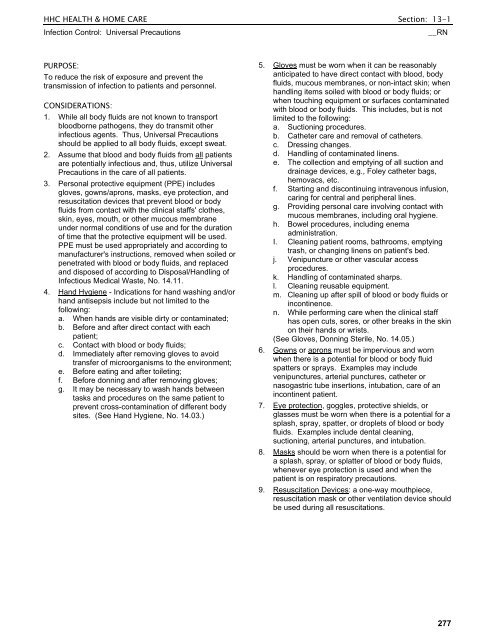HHC Health & Home Care Clinical Policy And
HHC Health & Home Care Clinical Policy And
HHC Health & Home Care Clinical Policy And
Create successful ePaper yourself
Turn your PDF publications into a flip-book with our unique Google optimized e-Paper software.
<strong>HHC</strong> HEALTH & HOME CARE Section: 13-1<br />
Infection Control: Universal Precautions __RN<br />
PURPOSE:<br />
To reduce the risk of exposure and prevent the<br />
transmission of infection to patients and personnel.<br />
CONSIDERATIONS:<br />
1. While all body fluids are not known to transport<br />
bloodborne pathogens, they do transmit other<br />
infectious agents. Thus, Universal Precautions<br />
should be applied to all body fluids, except sweat.<br />
2. Assume that blood and body fluids from all patients<br />
are potentially infectious and, thus, utilize Universal<br />
Precautions in the care of all patients.<br />
3. Personal protective equipment (PPE) includes<br />
gloves, gowns/aprons, masks, eye protection, and<br />
resuscitation devices that prevent blood or body<br />
fluids from contact with the clinical staffs' clothes,<br />
skin, eyes, mouth, or other mucous membrane<br />
under normal conditions of use and for the duration<br />
of time that the protective equipment will be used.<br />
PPE must be used appropriately and according to<br />
manufacturer's instructions, removed when soiled or<br />
penetrated with blood or body fluids, and replaced<br />
and disposed of according to Disposal/Handling of<br />
Infectious Medical Waste, No. 14.11.<br />
4. Hand Hygiene - Indications for hand washing and/or<br />
hand antisepsis include but not limited to the<br />
following:<br />
a. When hands are visible dirty or contaminated;<br />
b. Before and after direct contact with each<br />
patient;<br />
c. Contact with blood or body fluids;<br />
d. Immediately after removing gloves to avoid<br />
transfer of microorganisms to the environment;<br />
e. Before eating and after toileting;<br />
f. Before donning and after removing gloves;<br />
g. It may be necessary to wash hands between<br />
tasks and procedures on the same patient to<br />
prevent cross-contamination of different body<br />
sites. (See Hand Hygiene, No. 14.03.)<br />
5. Gloves must be worn when it can be reasonably<br />
anticipated to have direct contact with blood, body<br />
fluids, mucous membranes, or non-intact skin; when<br />
handling items soiled with blood or body fluids; or<br />
when touching equipment or surfaces contaminated<br />
with blood or body fluids. This includes, but is not<br />
limited to the following:<br />
a. Suctioning procedures.<br />
b. Catheter care and removal of catheters.<br />
c. Dressing changes.<br />
d. Handling of contaminated linens.<br />
e. The collection and emptying of all suction and<br />
drainage devices, e.g., Foley catheter bags,<br />
hemovacs, etc.<br />
f. Starting and discontinuing intravenous infusion,<br />
caring for central and peripheral lines.<br />
g. Providing personal care involving contact with<br />
mucous membranes, including oral hygiene.<br />
h. Bowel procedures, including enema<br />
administration.<br />
I. Cleaning patient rooms, bathrooms, emptying<br />
trash, or changing linens on patient's bed.<br />
j. Venipuncture or other vascular access<br />
procedures.<br />
k. Handling of contaminated sharps.<br />
l. Cleaning reusable equipment.<br />
m. Cleaning up after spill of blood or body fluids or<br />
incontinence.<br />
n. While performing care when the clinical staff<br />
has open cuts, sores, or other breaks in the skin<br />
on their hands or wrists.<br />
(See Gloves, Donning Sterile, No. 14.05.)<br />
6. Gowns or aprons must be impervious and worn<br />
when there is a potential for blood or body fluid<br />
spatters or sprays. Examples may include<br />
venipunctures, arterial punctures, catheter or<br />
nasogastric tube insertions, intubation, care of an<br />
incontinent patient.<br />
7. Eye protection, goggles, protective shields, or<br />
glasses must be worn when there is a potential for a<br />
splash, spray, spatter, or droplets of blood or body<br />
fluids. Examples include dental cleaning,<br />
suctioning, arterial punctures, and intubation.<br />
8. Masks should be worn when there is a potential for<br />
a splash, spray, or splatter of blood or body fluids,<br />
whenever eye protection is used and when the<br />
patient is on respiratory precautions.<br />
9. Resuscitation Devices: a one-way mouthpiece,<br />
resuscitation mask or other ventilation device should<br />
be used during all resuscitations.<br />
277







